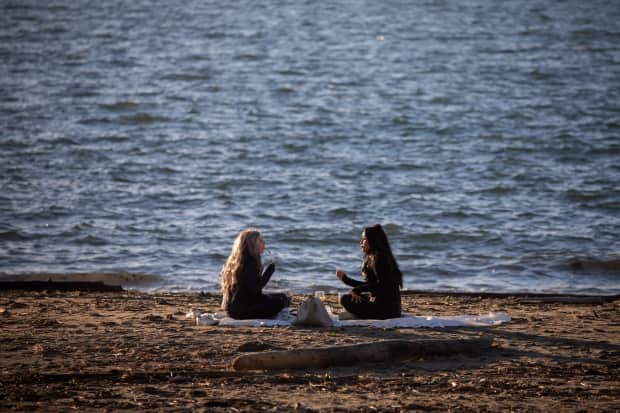Here's what we know about outdoor transmission of COVID-19 during winter
A year into the COVID-19 pandemic, our understanding of how and why the coronavirus spreads continues to change, especially as new variants emerge around the world.
While you may have spent much of last March wiping down your groceries, research has since shown that the coronavirus that causes COVID-19 is primarily spread through respiratory droplets, not surface transmission.
Like many respiratory viruses, the coronavirus spreads more effectively in the winter, with studies showing that prolonged, indoor contact in settings with poor ventilation are more likely to cause transmission.
But what do we know about how the virus spreads outdoors in winter?
Michael Brauer, a professor at the University of British Columbia School of Population and Public Health, said it's a difficult, dynamic question to answer — one that would need to take into account temperature, humidity, wind direction and more.
"When transmission does happen outdoors, it's very likely that it's people not wearing masks and standing close together."
What are droplets?
Brauer explained when you exhale you're humidifying the air around you, releasing breath at body temperature, 37 C.
Your breath is saturated with water and if you're carrying the coronavirus — whether you're symptomatic or not — you're exhaling microscopic virus particles coated in a layer of water.
What makes masks an effective tool against transmission is that they block these droplets from entering the air in the first place — though they're less effective at protecting you from someone else's droplets.

Does humidity make a difference?
Once droplets exit your body, their size changes depending on the conditions of the air around you, Brauer says. Humidity combined with temperature affects the way droplets react, with droplets becoming smaller the less humid the conditions.
A smaller droplet is likelier to hang in the air for a longer amount of time, while a larger one will sink to the ground, making it less likely to reach another person.
"There are no hard and fast rules. Everything is very dynamic. There's wind direction [for example]. But in general, the smaller those droplets are — so they tend to evaporate or dry out — they'll remain in the air longer," he said.
Brauer says it's possible that varying winter conditions in some parts of Canada may affect how the virus spreads outdoors, with colder and drier conditions in the east leading to droplets becoming smaller and staying airborne for longer.
"I'm not convinced that would be the case here in Vancouver. Those droplets could basically remain the same size, which means they're not going to last in the air for that long," he said.
However, an epidemiologist at the University of Toronto says conclusions about the impact of different seasons on outdoor transmissibility are mostly hypothetical.
Peter Juni, who is the scientific director of the COVID-19 science advisory table of Ontario, says that's because while the air may be less humid overall in the winter, humidity levels relative to temperature stay fairly consistent from summer to winter.
The biggest reason transmission increases in the winter, he says, is because people spend more time interacting indoors.
What about ventilation and movement?
Juni says when it comes to outdoor transmission, ventilation is the single most important factor.
"If the air is less humid, these particles stay longer airborne and this is a problem inside because you don't have good ventilation," he said. "However, outside what happens is any potential viral particles that are dissolved into aerosols, they get literally blown away."
Juni says if outdoor transmission was a serious concern we would have seen infections spike after the Black Lives Matter protests last summer.

Are outdoor activities safe?
Both Juni and Brauer say no one should be discouraged from exercising outdoors — most outdoor activities are safe, and it's usually the events leading up to exercise that are more likely to allow for transmission.
"Certainly, activities where you're close to people — that's where you need to be concerned. Skiing itself wouldn't be a particular concern, but waiting in line might be," Brauer said.
According to Juni, as long as people maintain a two-metre separation, they shouldn't be overly concerned. If people intend to speak for a longer time, he recommends that they increase that distance or wear masks.
What do studies of outdoor transmission say?
A review of peer-reviewed papers published in 2020 found that evidence supports the widely held belief that risk of SARS-CoV-2 transmission is lower outdoors. However, the authors noted that it is hard to draw conclusions about how the virus can spread outdoors because of a variety of factors including duration and frequency of personal contact, lack of PPE, and occasional indoor gathering during a largely outdoor experience.
One of the studies published last April shows that out of 7,000 cases of coronavirus transmission in China, just two occurred outdoors. However, the authors noted that their study was limited to outbreaks in China where very strict lockdown measures were implemented.
Overall, Juni says while outdoor gatherings are likely safe, it's easy for people to slip up and forget to distance.
"People do the wrong thing right now because they're tired, because we're all social animals. We would like to have a bit of our proximity. And the problem is we can't afford to do the wrong thing right now."
He says that's why public health orders restricting gatherings are likely to stay in place.

